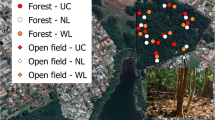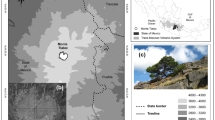Abstract
A stage-by-stage protocol for identifying simple or biased lottery, or non-lottery, patterns of seedling recruitment is outlined. For a simple (weighted) lottery to apply, the proportion of total individuals accounted for by one species at one stage of recruitment plotted against the proportion accounted for at a previous stage over a wide range of recruitment conditions should obey a linear regression with a=0 and b=1. For a biased lottery to hold, the regression is significant but a≠0 and/or b≠1. Demorgraphic, size and water relations data were collected over 3 years for four co-occurring Banksia species following two contrasting experimental fires. The first summer was exceptionally wet and the second was exceptionally hot and dry. Seedlings still alive by the 3rd year relative to the fire-killed parent plants conformed to a biased lottery in the case of B. speciosa and B. baxteri, while B. coccinea and B. pulchella had no mathematical structure (mean of the proportional ratios ≠ 1). Intervening stages, beginning with seed release, showed transient deterministic or simple lottery patterns in some cases, but the overriding trend was for biased lotteries. B. speciosa dominated the responses, with greater seed release than expected, fewer initial seedlings, lottery survival of 1st year seedlings and greater survival of 2nd year seedlings, when compared with the previous stages. Large seeds and subsequent high growth rates enabled B. speciosa to exploit soil water preferentially during the severe summer drought. The trend for B. speciosa to replace other species may be cancelled by stochastic processes not operating in this particular study.
Similar content being viewed by others
References
Boer PJ den (1986) The present status of the competitive exclusion principle. Trends Ecol Evol 1: 25–28
Bond WJ, Vlok J, Viviers M (1984) Variation in seedling recruitment of Cape Proteaceae after fire. J Ecol 72: 209–221
Bradstock RA, Bedward M (1992) Simulation of the effect of season of fire on post-fire seedling emergence of two Banksia species based on long-term rainfall records. Aust J Bot 40: 75–88
Burgman M, Lamont BB (1992) A stochastic model for the viability of Banksia cuneata: the role of fire, rainfall and genetics. J Appl Ecol 29: 719–727
Chesson P (1991) A need for niches? Trends Ecol Evol, 6: 26–28
Chesson P, Huntley N (1989) Short-term instabilities and long-term community dynamics. Trends Ecol Evol 4: 293–298
Chesson PL, Warner RR (1981) Environmental variability promotes coexistence in lottery competitive systems. Am Nat 117: 923–943
Connell JH, Slatyer RO (1977) Mechanisms of succession in natural communities and their role in community stability and organisation. Am Nat 111: 1119–1144
Cowling RM (1987) Fire and its role in coexistence and speciation in Gondwanan shrublands. S Afr J Sci 83: 106–112
Cowling RM, Lamont BB (1987) Post-fire recruitment of four cooccuring Banksia species. J Appl Ecol 13: 129–135
Enright NJ, Lamont BB (1992a) Survival, growth and water relations of Banksia seedlings on a sand mine rehabilitation site and adjacent scrub-heath sites. J Appl Ecol 29: 663–671
Enright NJ, Lamont BB (1992b) Recruitment variability in the resprouting shrub Banksia attenuata and non-sprouting congeners in the northern scrub-heaths of Western Australia. Acta Oecol 13: 727–741
Esler KJ, Cowling RM (1990) Effects of density on the reproductive output of Protea lepidocarpodendron. S Afr J Bot 55: 29–33
Fagerström T (1988) Lotteries in communities of sessile organisms. Trends Ecol Evol 3: 303–306
Fagerström T, Ågren GI (1979) Theory for coexistence of species differing in regeneration properties. Oikos 53: 1–10
Frazer JM, Davis SM (1988) Differential survival of chaparral seedlings during the first summer drought after wildfire. Oecologia 76: 215–221
George AS (1981) The genus Banksia L.f. (Proteaceae). Nuytsia 3: 239–414
Grubb PJ (1977) The maintenance of species richness in plant communities: the importance of the regeneration niche. Biol Rev 52: 107–145
Hobbs RJ, Currall JE, Gimingham CH (1984) The use of thermocolor pyrometers in the study of heath fire behaviour. J Ecol 72: 241–250
Jurado E, Westoby M (1992) Seedling growth in relation to seed size among species of arid Australia. J Ecol 80: 407–416
Kalisz S, McPeek MA (1993) Extinction dynamics, population growth and seed banks: an example using an age-structured annual. Oecologia 95: 314–320
Lamont BB (1992) Functional interactions within plants — the contribution of keystone and other species to biological diversity. In: Hobbs RJ (ed) Biodiversity in mediterranean ecosystems in Australia. Surrey Beatty, Chipping Norton, NSW, pp 95–127
Lamont BB (1995) Conservation biology of banksias in southwestern Australia. In: Hopper S, Chappill J, Harvey M, Marchant N (eds) Systematics. evolution and conservation of the Western Australia biota. Surrey Beatty, Chipping Norton, NSW (in press)
Lamont BB, Barker MJ (1988) Seed bank dynamics of a serotinous, fire-sensitive Banksia species. Aust J Bot 36: 193–203
Lamont BB, Bergl SM (1991) Water relations, shoot and root architecture, and phenology of three co-occurring Banksia species: no evidence for niche differentiation in the pattern of water use. Oikos 60: 291–298
Lamont BB, Connell SJ, Bergl SM (1991a) Seed bank and population dynamics of Banksia cuneata: the role of time, fire and moisture. Bot Gaz 152: 114–122
Lamont BB, Le Maitre D, Cowling RM, Enright NJ (1991b) Canopy seed storage in woody plants. Bot Rev 57: 277–317
Lamont BB, Witkowski ETF, Enright NJ (1993) Post-fire litter microsites: safe for seeds, unsafe for seedlings. Ecology 74: 501–512
Laurie H, Cowling RM (in press) Lottery coexistence models extended to plants with non-overlapping generations. J Veg Sci
Lavorel S, Lebreton JD (1992) Evidence for lottery recruitment in Mediterranean old fields. J Veg Sci 3: 91–100
O'Dowd DJ, Gill AM (1984) Predator satiation and site alteration following fire: Mass reproduction of alpine ash (Eucalyptus delegatensis) in southeastern Australia. Ecology 65: 1052–1066
Shmida A, Ellner S (1984) Coexistence of plant species with similar niches. Vegetatio 58: 29–55
Stock WD, Pate JS, Delfs J (1990) Influence of seed size and quality on seedling development under low nutrient conditions in five Australian and South African members of the Proteaceae. J Ecol 78: 1005–1020
Taylor A, Hopper SD (1988) The Banksia atlas. Australian Government Publishing Service, Camberra
Tilman D (1987) Secondary succession and the pattern of plant dominance along experimental nitrogen gradients. Ecol Monogr 57: 189–214
Tilman D, Wedin D (1991) Dynamics of nitrogen competition between successional grasses. Ecology 72: 1038–1049
Warner RR, Chesson PL (1985) Coexistence mediated by recruitment fluctuations: a field guide to the storage effect. Am Nat 125: 769–787
Witkowski ETF, Lamont BB, Connell SJ (1991) Seed bank dynamics of three co-occurring banksias in south coastal Western Australia: the role of plant age, cockatoos, senescence and interfire establishment. Aust J Bot 39: 385–397
Witkowski ETF, Lamont BB, Walton CS, Radford S (1992) Leaf demography, sclerophylly and ecophysiology of two banksias with contrasting leaf life spans. Aust J Bot 40: 849–882
Yeaton RI, Bond WJ (1991) Competition between two shrub species: dispersal differences and fire promote coexistence. Am Nat 138: 328–341
Author information
Authors and Affiliations
Rights and permissions
About this article
Cite this article
Lamont, B.B., Witkowski, E.T.F. A test for lottery recruitment among four Banksia species based on their demography and biological attributes. Oecologia 101, 299–308 (1995). https://doi.org/10.1007/BF00328815
Received:
Accepted:
Issue Date:
DOI: https://doi.org/10.1007/BF00328815




